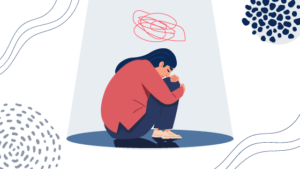When people have suicidal thoughts,
therapists are often the last people they tell.

How did we get here?
The epidemic of suicide in the US shows no sign of abating. Last year, 50,000 Americans died by suicide, representing a 2.6% increase over the previous year. Suicide is the leading cause of death for people between the ages of 10-24. While the complex drivers of this ongoing tragedy continue to be theorized, studied, and discussed, the response to the question of what to do if someone has thoughts of suicide has been singular and clear: see a mental health professional.
Will Seeing a Mental Health Professional Help?
While it seems common sense that mental health professionals are the best people to help people with suicidal thoughts, we often don’t get the chance: half of clients who are already in therapy conceal suicidal thoughts from their therapists. The primary reason for concealment? Fear of involuntary hospitalization. Those who have been involuntarily hospitalized before or were threatened with hospitalization are even more likely to conceal thoughts or to stay away from mental health care altogether. Of course, patients also conceal suicidal thoughts from other health professionals. But aren’t we, as mental health professionals, better equipped, more skilled, more trusted in this area? Not necessarily.
Our most common responses to people’s suicidal thoughts has eroded patients’ trust in us.
Disclosures are often treated as urgent regardless of how mild, intermittent, passive, or absent of intent. It’s as if when we hear thoughts of suicide, we stop being therapists and put our risk-management hat on: “Have you made any plans? And do you have the means to do this?…..” We write contracts, call the crisis team, the police, and the hospital; we send people to emergency rooms. Of course, one of the greatest fears of every helping professional (likely of every caring person) is that we didn’t do everything we could to prevent a death by suicide. Our systems often enforce this cookie-cutter, “better-safe-than-sorry” protocol because of liability concerns. The problem with this protocol is twofold: 1) it doesn’t help, as this approach is divorced from the evidence, and 2) it often causes harm to the people we are trying to help.
Lack of evidence:
Further, people have different relationships with these thoughts: some are deeply troubled by thoughts like these, and others are not bothered. People may feel sure they will never act on their thoughts, and others fear they might. Some people have had suicidal thoughts since they were children and have a long relationship with these thoughts; some are even comforted by having a consistent “exit strategy” that they never execute.
There is no clear association between sharing suicidal thoughts and attempting suicide. White men over 75, who have one of the highest prevalence of suicides, also have one of the lowest disclosure rates of suicidal ideation. Most people who have suicidal thoughts do not attempt suicide. Our protocols are perceived as, and often are, concerned primarily about liability—our own or our organization’s. Worse, some of these liability management actions, such as “no suicide” contracts and ED referrals, have no demonstrated evidence for lowering suicide risk; in fact, there’s evidence of harm.

Patients’ Fear of Hospitalization is Warranted
Data suggest that involuntary hospitalization leads to low levels of treatment satisfaction, has adverse effects on the patient-therapist relationship, increases the risk of emergency re-hospitalization, can lead to long-term avoidance of mental health care, and can be experienced as traumatic and stigmatizing.
For youth, the data is even worse, with involuntary hospitalization reported to have negative impacts on the trust of mental health professionals, including an unwillingness to disclose suicidal feelings or intentions during and after the hospitalization. Factors contributing to distrust include perceptions of hospitalization as more punitive than therapeutic, staff as more judgmental than empathetic, and care as more about control than treatment. But perhaps most disturbingly, perceived coercion for hospitalization has been shown in some cases to increase the rate of suicide attempts after discharge.
Research and news reports have documented patient harm in inpatient psychiatric settings, including abuse, neglect, medication errors, violence, sexual assault, patient self-harm, poor sanitation, and inappropriate restraint and seclusion. Worse, the longer the hospital stay is, the higher the odds of experiencing harm. People of color disproportionately suffer from harm from hospitalization. It is perhaps no surprise that after discharge, patients often experience higher suicide risk.
The Fallacy of the Emergency Department as Help
Referrals to the emergency room are perhaps the most egregious response to endorsement of suicidal ideation. The research is clear that the emergency department (ED) is much more likely to harm patients, particularly those with mental health struggles. 60% of people who had self-harmed and were referred to the emergency department left without a mental health assessment. Those who do receive one and are deemed worthy of a psychiatric hospital bed wait an average of 11 hours in the emergency room. Every hour in an emergency room causes more harm: psychiatric symptoms exacerbate, anxiety increases, hopelessness deepens, and anger often spikes. Even if a patient makes it through the intensely dehumanizing experience, being in the ED does little to lower suicide risk— research from California shows a higher rate of suicide for those who had an ED visit in the prior year.
What Can We Do Differently?
In The Lay Counselor Academy, where we train those without mental health degrees or licenses to do mental health counseling, we address suicidal ideation in clients differently. We know a trusting, genuine, empathic relationship facilitates more honest disclosures about suicidal thoughts, so we focus on this first before asking about suicidal thoughts. We train counselors to share specifically the criteria for involuntary hospitalization with clients before we ask questions about suicidal thoughts. With this information, we address the often exaggerated ideas about what would trigger involuntary hospitalization so clients know they can share these thoughts without fear of losing their autonomy. We encourage new counselors to approach suicidal thoughts with curiosity and kindness and see them as fertile ground for deeper exploration and understanding. We practice asking questions about the client’s relationship to the thoughts and how troubling they are to the client (sometimes not at all!), what part of them thinks these thoughts, and what part wants to stay alive on this planet. We teach counselors to avoid rushing into dehumanizing risk management protocols or referring to emergency rooms to shift risk, despite knowing clients won’t get the care they need there. (and, of course, we emphasize the importance of consultation with clinical supervisors after sessions, with any suicidal or self-harm disclosures, past or present).

Most of us don’t have the power to change institutional dehumanization in psychiatric hospitals or emergency rooms; we may not be in a position to revamp suicidal ideation protocols at our organization. All of us who work with clients, though, can:
- Change our response away from fear and risk-shifting to one that cultivates calmness and curiosity about suicidal thoughts. We can recall how common these thoughts are, the range of severity between people, the fact that our clients have been dealing with these long before they shared with us, and likely have ways they already manage them. Most of all, remind ourselves that we can help with these thoughts, just as we can help with other thoughts that might be causing suffering—in fact, CBT is effective with suicidal ideation.
- Validate our clients’ fears. We don’t want to gaslight clients about their fears of hospitalization or hesitations about the ED. Instead, we validate them. Clients may have had past harmful experiences with these places or know others who have. Their hesitation to disclose is a self-protective decision, a strength, as it accurately reflects the probable and potential harm.
- Avoid ED referrals or calling the police. Calling the police must be struck from our suicide protocols. We are putting people in danger if we continue this practice, and the danger is not borne equally—people of color are disproportionately harmed.
- Stay true to the north star of healing and help. Strengthen the therapeutic alliance, build trust through empathy and authenticity, avoid the trap of control and coercion, and use these disclosures better to understand our fellows’ unique challenges and strengths.





